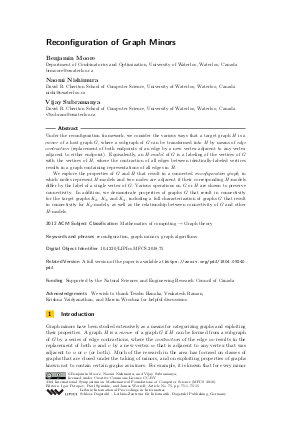Reconfiguration of Graph Minors
Authors Benjamin Moore, Naomi Nishimura, Vijay Subramanya
-
Part of:
Volume:
43rd International Symposium on Mathematical Foundations of Computer Science (MFCS 2018)
Part of: Series: Leibniz International Proceedings in Informatics (LIPIcs)
Part of: Conference: Mathematical Foundations of Computer Science (MFCS) - License:
 Creative Commons Attribution 3.0 Unported license
Creative Commons Attribution 3.0 Unported license
- Publication Date: 2018-08-27
File

PDF
LIPIcs.MFCS.2018.75.pdf
- Filesize: 382 kB
- 15 pages
Document Identifiers
Related Versions
Subject Classification
ACM Subject Classification
- Mathematics of computing → Graph theory
Keywords
- reconfiguration
- graph minors
- graph algorithms
Metrics
- Access Statistics
-
Total Accesses (updated on a weekly basis)
0PDF Downloads0Metadata Views
Abstract
Under the reconfiguration framework, we consider the various ways that a target graph H is a minor of a host graph G, where a subgraph of G can be transformed into H by means of edge contraction (replacement of both endpoints of an edge by a new vertex adjacent to any vertex adjacent to either endpoint). Equivalently, an H-model of G is a labeling of the vertices of G with the vertices of H, where the contraction of all edges between identically-labeled vertices results in a graph containing representations of all edges in H. We explore the properties of G and H that result in a connected reconfiguration graph, in which nodes represent H-models and two nodes are adjacent if their corresponding H-models differ by the label of a single vertex of G. Various operations on G or H are shown to preserve connectivity. In addition, we demonstrate properties of graphs G that result in connectivity for the target graphs K_2, K_3, and K_4, including a full characterization of graphs G that result in connectivity for K_2-models, as well as the relationship between connectivity of G and other H-models.
Cite As Get BibTex
Benjamin Moore, Naomi Nishimura, and Vijay Subramanya. Reconfiguration of Graph Minors. In 43rd International Symposium on Mathematical Foundations of Computer Science (MFCS 2018). Leibniz International Proceedings in Informatics (LIPIcs), Volume 117, pp. 75:1-75:15, Schloss Dagstuhl – Leibniz-Zentrum für Informatik (2018)
https://doi.org/10.4230/LIPIcs.MFCS.2018.75
BibTex
@InProceedings{moore_et_al:LIPIcs.MFCS.2018.75,
author = {Moore, Benjamin and Nishimura, Naomi and Subramanya, Vijay},
title = {{Reconfiguration of Graph Minors}},
booktitle = {43rd International Symposium on Mathematical Foundations of Computer Science (MFCS 2018)},
pages = {75:1--75:15},
series = {Leibniz International Proceedings in Informatics (LIPIcs)},
ISBN = {978-3-95977-086-6},
ISSN = {1868-8969},
year = {2018},
volume = {117},
editor = {Potapov, Igor and Spirakis, Paul and Worrell, James},
publisher = {Schloss Dagstuhl -- Leibniz-Zentrum f{\"u}r Informatik},
address = {Dagstuhl, Germany},
URL = {https://drops.dagstuhl.de/entities/document/10.4230/LIPIcs.MFCS.2018.75},
URN = {urn:nbn:de:0030-drops-96573},
doi = {10.4230/LIPIcs.MFCS.2018.75},
annote = {Keywords: reconfiguration, graph minors, graph algorithms}
}
Author Details
- Department of Combinatorics and Optimization, University of Waterloo, Waterloo, Canada
- David R. Cheriton School of Computer Science, University of Waterloo, Waterloo, Canada
Funding
Supported by the Natural Sciences and Engineering Research Council of Canada
References
-
Richard C. Brewster, Jae-Baek Lee, Benjamin Moore, Jonathan A. Noel, and Mark Siggers. Graph homomorphism reconfiguration and frozen h-colourings. CoRR, arXiv:1712.00200, 2017.

-
Erik D. Demaine and MohammadTaghi Hajiaghayi. Graphs excluding a fixed minor have grids as large as treewidth, with combinatorial and algorithmic applications through bidimensionality. In Proceedings of the Sixteenth Annual ACM-SIAM Symposium on Discrete Algorithms, pages 682-689. Society for Industrial and Applied Mathematics, 2005.

-
Reinhard Diestel. Graph theory. Springer-Verlag, Electronic Edition, 2005.

- Guoli Ding and Chengfu Qin. Generating 4-connected graphs, 2015. URL: https://www.math.lsu.edu/~ding/chain4.pdf.
-
Tesshu Hanaka, Takehiro Ito, Haruka Mizuta, Benjamin Moore, Naomi Nishimura, Vijay Subramanya, Akira Suzuki, and Krishna Vaidyanathan. Reconfiguring spanning and induced subgraphs. In Proceedings of the 24^th International Computing and Combinatorics Conference, 2018.

-
Takehiro Ito, Erik D. Demaine, Nicholas J. A. Harvey, Christos H. Papadimitriou, Martha Sideri, Ryuhei Uehara, and Yushi Uno. On the complexity of reconfiguration problems. Theoretical Computer Science, 412(12-14):1054-1065, 2011.

-
Marcin Kamiński, Paul Medvedev, and Martin Milanič. Complexity of independent set reconfigurability problems. Theoretical Computer Science, 439:9-15, 2012.

-
Anna Lubiw, Zuzana Masárová, and Uli Wagner. Proof of the orbit conjecture for flipping edge-labelled triangulations. In Proceedings of the 33^rd International Symposium on Computational Geometry, 2017.

-
Nicola Martinov. Uncontractable 4-connected graphs. Journal of Graph Theory, 6(3):343-344, 1982.

-
Moritz Mühlenthaler. Degree-contrained subgraph reconfiguration is in P. In 40th International Symposium on Mathematical Foundations of Computer Science, pages 505-516, 2015.

-
N. Nishimura. Introduction to reconfiguration. Algorithms, 11(4):52, 2018.

-
Neil Robertson and P.D. Seymour. Graph minors. XX. Wagner’s conjecture. Journal of Combinatorial Theory, Series B, 92(2):325-357, 2004. Special Issue Dedicated to Professor W.T. Tutte.

-
W.T. Tutte. A theory of 3-connected graphs. Indagationes Mathematicae (Proceedings), 64:441-455, 1961.

-
Jan van den Heuvel. The complexity of change. Surveys in Combinatorics 2013, 409:127-160, 2013.

